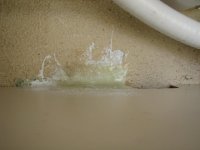C-Pup16 in Los Angeles
New member
I have a 2003 16 ft CD cruiser that I usually keep garaged. When at sea or when washing it on its trailer however, spray water will pool inside the boat until I dry it out.
Some of the rivets attaching the seat platform and side wall to the floor have sheared off over the years. It occurred to me that this creates a hole for passage of water into the hull and balsa core… not good.
What is your suggested remedy?
1) Leave it and shoot silicon into the former rivet area;
2) Shoot silicon in the hole then screw-in a shallow stainless screw;
3) re-revet the holes;
How much “meat” is there to the bottom hull for #2 solution, screws? So you have a suggestion on screw size?
Is re-riveting possible? What kind of business might do that in Los Angeles, CA?
Thank you and be well.
Keith Dager
C-PUP16 in Los Angeles, CA
Some of the rivets attaching the seat platform and side wall to the floor have sheared off over the years. It occurred to me that this creates a hole for passage of water into the hull and balsa core… not good.
What is your suggested remedy?
1) Leave it and shoot silicon into the former rivet area;
2) Shoot silicon in the hole then screw-in a shallow stainless screw;
3) re-revet the holes;
How much “meat” is there to the bottom hull for #2 solution, screws? So you have a suggestion on screw size?
Is re-riveting possible? What kind of business might do that in Los Angeles, CA?
Thank you and be well.
Keith Dager
C-PUP16 in Los Angeles, CA


